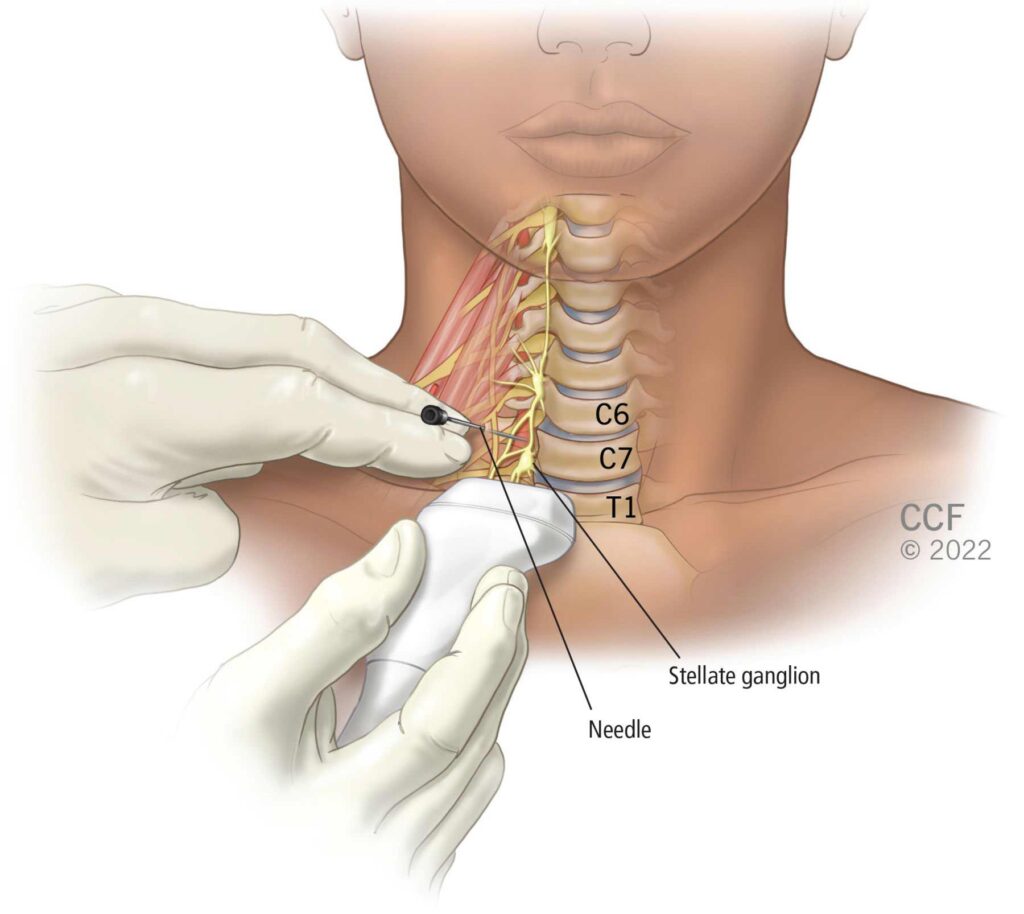
Stellate ganglion block (SGB) is an innovative procedure in Canada that targets the sympathetic nervous system and offers hope for those who’ve exhausted traditional therapies. Whether you’re facing complex regional pain syndrome, post-traumatic stress disorder, or debilitating head and neck pain, SGB could be the breakthrough you’ve been searching for. Let’s explore how this cutting-edge treatment is reshaping pain management and mental health care across Canada.
What is a Stellate Ganglion Block?
A stellate ganglion block (SGB) is an interventional pain relief and management technique gaining traction in Canada. It targets the stellate ganglion, a cluster of sympathetic nerves in the neck, injecting a local anesthetic to temporarily “block” their function. This can reduce pain signals and reset the sympathetic nervous system’s activity.
SGB is particularly effective for conditions involving the head, neck, upper chest, and arms, showing promise in treating complex regional pain syndrome (CRPS) and post-traumatic stress disorder (PTSD).
Anatomy of the Stellate Ganglion
The stellate ganglion is a star-shaped cluster of nerve cells located in the neck, part of the sympathetic nervous system that controls our “fight or flight” response. Understanding its precise location is crucial for SGB’s success, and Field Trip Health uses advanced imaging techniques like ultrasound or fluoroscopy for accurate needle placement.

Conditions Treated with Stellate Ganglion Block
SGB has shown effectiveness in treating various conditions resistant to conventional therapies.
Complex Regional Pain Syndrome (CRPS)
CRPS often affects one limb after an injury. SGB has proven effective for upper extremity CRPS, significantly reducing pain intensity and improving function. Many patients report decreased swelling and improved mobility after treatment.
Posttraumatic Stress Disorder (PTSD)
SGB shows promising results in treating combat-related PTSD by resetting the fight-or-flight response. Patients often report improvements in symptoms such as hyper-vigilance, anxiety, and sleep disturbances.
Peripheral Vascular Disease
For patients with peripheral vascular disease, SGB can promote vasodilation and improve blood flow, alleviating pain and circulation issues in the upper extremities.
Ventricular Arrhythmias
SGB has emerged as a potential treatment for refractory ventricular arrhythmias, stabilizing heart rhythms when standard treatments have failed.
The SGB Procedure
The SGB procedure involves careful preparation and execution.
Preparation for Stellate Ganglion Blockade
Before the procedure, we conduct a thorough medical evaluation. On the day of the procedure, you’ll be asked to avoid eating or drinking for several hours, wear comfortable clothing, and arrange for someone to drive you home afterward.
Techniques: Ultrasound, Fluoroscopy, and CT Guidance
We utilize advanced imaging techniques for precise needle placement. Ultrasound-guided SGB is preferred for real-time visualization, while fluoroscopy and CT guidance may be used in complex cases.
What to Expect During the Procedure
You’ll be positioned comfortably, and a local anesthetic will be applied to minimize discomfort. Once the needle is positioned, a small amount of local anesthetic is injected around the stellate ganglion, often resulting in a warm sensation. The procedure typically takes 15-30 minutes.
Benefits of Stellate Ganglion Block for Canadians
SGB offers significant benefits for Canadians struggling with chronic pain and anxiety-related conditions.
Pain Relief in Head, Neck, Upper Arm, and Upper Chest
SGB effectively interrupts pain signals in the upper body, resulting in immediate pain reduction. Patients with chronic headaches and neck pain often experience substantial relief.
“Resetting” Neurotransmitters for Anxiety Reduction
SGB can “reset” the brain’s neurotransmitter balance, significantly reducing anxiety symptoms. Many patients with PTSD report improved emotional stability and sleep quality post-treatment.
It’s most effective when combined with comprehensive treatment plans, including psychological support.
Potential Risks and Side Effects
While SGB is generally safe, patients should be aware of potential risks and side effects.
Common Side Effects of SGB
Most side effects are temporary, including drooping eyelids, eye redness, and warmth in the treated arm and face. These typically resolve within hours. Patients may also experience temporary hoarseness or nasal congestion.
Rare Complications
Rare complications can occur, such as infection, bleeding, or accidental injection into nearby structures. Risks are minimized through imaging guidance. Patients should inform their doctor of any unusual symptoms post-procedure.
Effectiveness of Stellate Ganglion Block
Research increasingly supports SGB’s effectiveness for conditions like PTSD and chronic pain syndromes.
Clinical Studies and Research Findings
Recent studies show significant reductions in PTSD symptoms after SGB. Additionally, systematic reviews demonstrate SGB’s efficacy in treating CRPS, aligning with my clinical observations of improved patient outcomes.
Patient Testimonials
Patient experiences often provide compelling evidence of SGB’s effectiveness. Many report reduced anxiety and improved sleep quality. One veteran described SGB as “like a switch being flipped,” dramatically decreasing hypervigilance and nightmares.

Accessing Stellate Ganglion Block in Canada
Accessing SGB in Canada involves navigating the healthcare system.
Finding Qualified Practitioners
Start by consulting your family doctor or a pain specialist for a referral. When choosing a provider, ensure they have specific experience performing SGB for mental health indications, not just pain management. Look for interventional radiologists or anesthesiologists who are trained in ultrasound-guided or fluoroscopy-guided SGB, as proper technique is essential for both safety and effectiveness.
Insurance Coverage and Costs
Coverage for SGB (Stellate Ganglion Block) varies by province and is generally limited when used for mental health indications. While it may be covered if deemed medically necessary for other conditions, coverage for outpatient mental health applications is rare. Our team can typically schedule your procedure within the same week, and it’s performed by experienced interventional radiologists. If you’re exploring SGB, make sure you choose a provider who has specific experience with this procedure for mental health treatment.
Aftercare and Follow-Up
Proper aftercare and follow-up are crucial for maximizing benefits post-SGB.
Post-Procedure Care Instructions
Rest for about 30 minutes after the procedure. Avoid strenuous activities for 24 hours and apply ice to the injection site if needed. Monitor for any signs of infection.
Monitoring Progress and Potential Need for Repeat Treatments
A follow-up appointment is typically scheduled within 1-2 weeks to assess treatment response. Keeping a symptom diary can help gauge effectiveness. The duration of SGB effects varies; some may require repeat procedures for sustained benefits, especially for chronic conditions.
Stellate Ganglion Block in the Future
As a physician dedicated to innovative pain management and mental health treatments, I’ve witnessed the transformative power of stellate ganglion block (SGB) for many Canadians. This procedure offers hope for those grappling with chronic pain and anxiety-related conditions resistant to conventional therapies. SGB uniquely alleviates head, neck, upper arm, and chest pain while resetting neurotransmitters to ease anxiety. While not a magic bullet, its potential to disrupt the cycle of pain and anxiety can be life-changing, allowing patients to engage more fully in therapies and daily activities. If you’re facing these challenges, discuss SGB with your healthcare provider—it could unlock a more balanced life.
Book your free discovery call to learn more about Stellate Ganglion Block at Field Trip Health here.
Field Trip Health Toronto offers additional alternative treatments for treatment-resistant depression, anxiety, PTSD, and other mental health disorders such as Stellate Ganglion Block therapy, MDMA therapy, Psilocybin therapy, Neurofeedback therapy, and repetitive Transcranial Magnetic Stimulation (rTMS)
About the Author

Dr. Mario Nucci MD CCFP is a licensed Family Physician with a passion for mental health and the development of new therapies. He is actively engaged in research with a faculty associate professorship at Northern Ontario School of Medicine, and research collaborations with the University of Ottawa, University of Calgary, Lakehead University, Concordia University and Vancouver Island University.
Dr. Nucci is the founder of Bay and Algoma Health Centre in 2019, a walk-in and addiction medicine clinic. He founded the Canadian Centre for Psychedelic Healing in 2019, now operating as Field Trip Health, providing cutting edge mental health care in Toronto, Montreal, Vancouver, Ottawa, Hamilton, Kitchener-Waterloo, Thunder Bay, Sault Ste. Marie, and at-home.